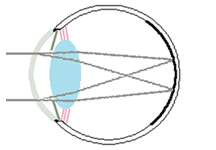| Normal vision: Light passes through the cornea and is refracted. The iris can increase or decrease the pupillary diameter to determine the amount of light that enters the eye. The light is further refracted by the crystalline lens, which can be adjusted in shape by the smooth muscle of the ciliary body that tugs on the suspensory ligaments. The aqueous humor in the anterior chamber and the posterior chamber has minimal impact upon refraction of light. Ideally, the light is focused precisely upon the retina.
|

| Myopia: When the shape of the eye is too long, then the light entering the eye becomes focused in front of the retina and vision is blurred. The crystalline lens can partly adjust for this situation at near distances, so myopia is also known as "nearsightedness". However, vision at far distances remains blurred. Glasses or contact lenses help to adjust for myopia. About one-fourth of all persons have some degree of myopia.
|

| Hyperopia: When the shape of the eye is too short, then the focal point for light entering the eye falls behind the retina, and vision is blurred. The crystalline lens can help somewhat to focus the light forward, but once presbyopia occurs, then far vision will be better than near vision. Glasses or contact lenses help to adjust for hyperopia.
|

| Astigmatism: When the shape of the corneal curvature is ovoid, more like a rugby ball than a basketball, then light entering the eye is distorted as it is refracted unevenly. Vision is blurred at all distances. Glasses have traditionally been the only choice for correction, but contact lenses are now able to correct some cases as well. About half of persons with myopia also have some degree of astigmatism.
|

| Presbyopia: As persons age, the crystalline lens loses its flexibility and cannot accommodate focusing, particularly at near distances. In the fifth decade, nearly everyone experiences presbyopia. Objects must be held farther away to see clearly. Persons who never had corrective lenses will require them for viewing close objects (reading), while persons who have lenses will need bifocals. Persons with myopia may not need corrective lenses for close distances with the onset of presbyopia.
|
| Corrective Lenses
|
|---|
| In order to correct vision problems, lenses in the form of glasses and contacts can be utilized. The lenses provide curvature to bend light entering through the cornea. The strength of the curvature correction is given in diopters. Since the lens must be more convex to correct for myopia, the correction is given as a negative number, while a positive number indicates more concavity to correct for hyperopia or astigmatism. In general, no more than -3 diopters of correction is considered mild for myopia, while less than +1 diopter of astigmatism is considered mild.
|
| Bifocal lenses come in two major categories: traditional bifocals and progressive (no-line) bifocals. With traditional bifocals, a separate portion of lens is present through which near objects must be viewed. Progressive bifocals have a continuous correction increasing in strength toward the bottom of the visual field, and wearers of this lens learn to look through different parts of the lens at different distances of view.
|
| Corrective Laser Surgery
|
|---|
| One method to correct mild to moderate vision problems is photorefractive keratectomy (PRK). A computer-guided laser is used to sculpt a portion of the cornea to make the correction.
|
| Another method of vision correction for both mild as well as more severe vision problems is laser assisted in situ keratomileusis (LASIK). First, a microkeratome is used to cut a flap of corneal tissue from which a precise amount of corneal tissue can be removed from the inner surface by the laser. The flap is then put back.
|











